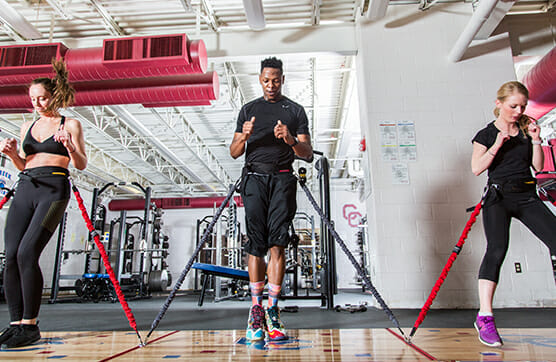The Future of High School Weight Rooms

The Future of High School Weight Rooms
 The days of small, grungy weight rooms with rusted barbells or outdated Universal machines that only the most committed athletes dared step foot into, are becoming obsolete. The forefront of high school sports performance is breaking ground throughout the country with the help of Perform-X Training Systems. High schools, and middle schools, with big visions and forward thinking individuals, have taken the next step in bridging the gap between traditional weight lifting and performance integration concepts.
The days of small, grungy weight rooms with rusted barbells or outdated Universal machines that only the most committed athletes dared step foot into, are becoming obsolete. The forefront of high school sports performance is breaking ground throughout the country with the help of Perform-X Training Systems. High schools, and middle schools, with big visions and forward thinking individuals, have taken the next step in bridging the gap between traditional weight lifting and performance integration concepts.

Coaches and physical education instructors now have access to an area that contains versatility for all sports and class/courses that includes instructive pieces that can fit into their physical education curriculum and coaching philosophy. This concept allows coaches and educators the opportunity to incorporate basic exercise principles (e.g., running, jumping, lifting techniques, and agility) within their physical education classes, in addition to advanced performance techniques for the student-athlete. All students, regardless of age or ability, now have the opportunity to participate and learn correct movement patterns in a variety of athletic activities not only for success in sports, but for future physical wellness.
Historically, the high school weight room has mimicked the college weight room concept, with the exception of a slightly smaller budget. The pillars of weight lifting such as the bench press, squat, and power clean are essential for producing forceful movements in the athletic arena, but can be intimidating for young student-athletes, especially young males and females. The goal is to build a platform embracing all ability levels in a space that traditionally was built to accommodate football athletes. The principles of building strength are still in place, but combined with performance aspects that can better prepare young athletes, female athletes, and students for an active lifestyle in or around sports.
The Performance Zone Concept
 The performance area should contain specific areas, or ZONES of Performance that have tools or resources that cater to the main pillars of human performance – strength, power, speed and functional movement. The weight training area has a standard strength makeup but with performance concepts to accentuate the space.
The performance area should contain specific areas, or ZONES of Performance that have tools or resources that cater to the main pillars of human performance – strength, power, speed and functional movement. The weight training area has a standard strength makeup but with performance concepts to accentuate the space.
New to the landscape are customized platforms, preferably inlaid, with a special integrated track system (Trak-X™) offering built-in plyometric progressions and variable resistance applications for lifting movements. Simply put, the once above-ground platforms that would clutter the weight room are now at floor level with an integrated system that allows for loaded and unloaded plyometrics, Olympic movements and traditional weight lifting.
Along with the inlaid platform/Trak-X/plyometric concept, other machine concepts have made their way into the set up. The high speed treadmill, a specially designed leg press which emphasizes single leg pressing movements and jumping, and a hip machine that targets all planes of hip musculature development. Speed development, explosive leg strength, core stability, and hip strengthening enhance athletic ability and more importantly, decrease the chances of injury in all sports. Although machines tend to get a bad reputation among many strength training specialists due to single joint isolation, the muscle training aspects actually compliment the core and Olympic lifts, much like working the triceps compliments the bench press.
The new evolution of the high school weight room has become reality across the country, in the form of a ‘high school performance center’. The gap between traditional weight room concepts and performance center secrets has been bridged so that future generations can have access to the most cutting-edge technology in the field of sports performance, during the most crucial stages of development. Schools are re-defining the roles of coaches, administrators, and physical educators despite a diminishing demand for physical education classes, and empowered them with tools to build a better student and student-athlete.